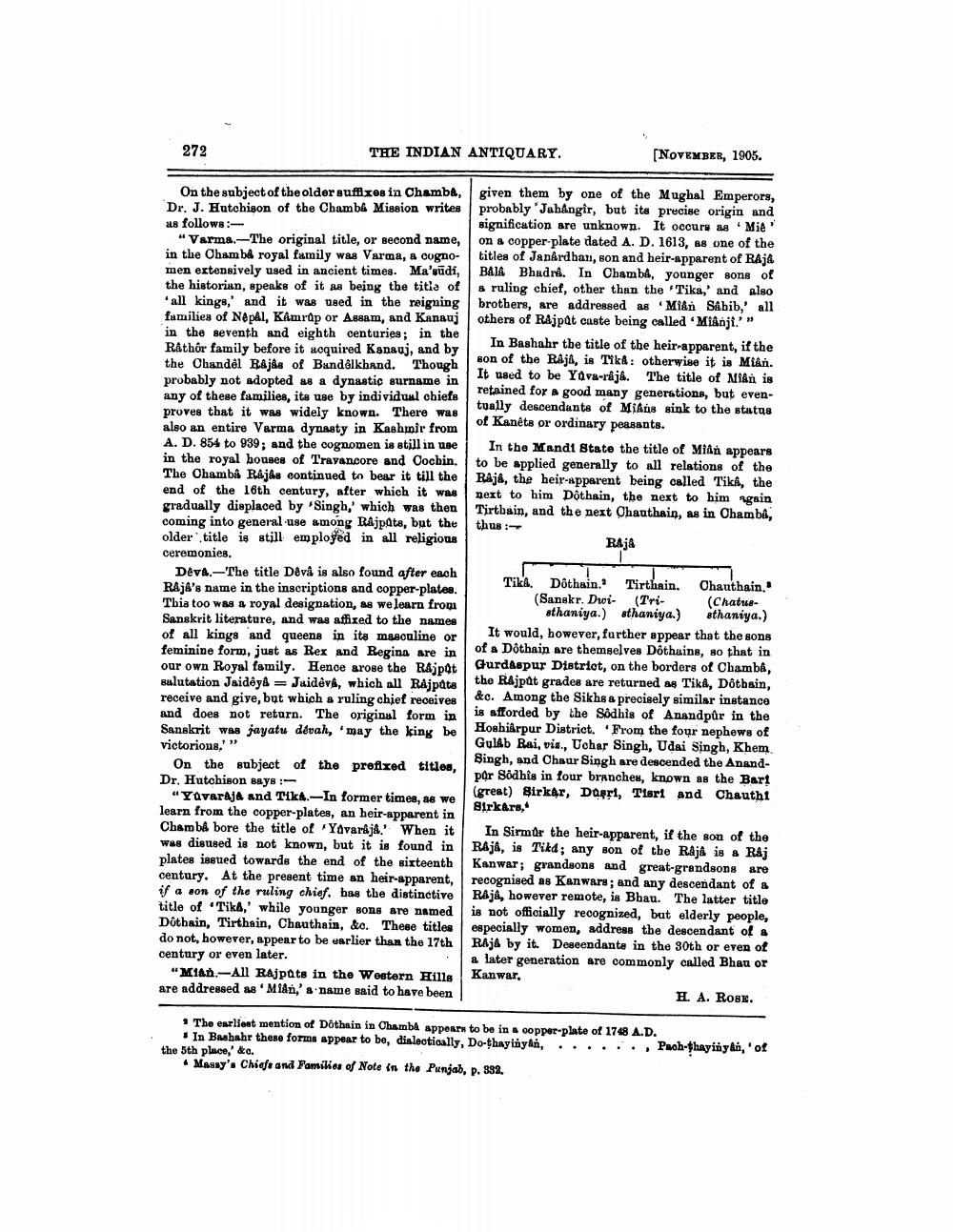________________
272
THE INDIAN ANTIQUARY.
(NOVEMBER, 1905.
given them by one of the Mughal Emperors, probably 'Jahangir, but ita precise origin and signification are unknown. It occurs as Mie" on a copper-plate dated A. D. 1613, as one of the titles of Janardhan, son and heir-apparent of RAJA BAIA Bhadra. In Chambe, younger sons of s ruling chief, other than the "Tika,' and also brothers, are addressed as Mian Sabib,' all others of Rajpat caste being called Miânji.'"
In Bashahr the title of the heir-apparent, if the son of the Raja, is Tika: otherwise it is Mian. It used to be Yava-raja. The title of Man is retained for a good many generations, but eventually descendants of Miaus sink to the status of Kanêts or ordinary peasants.
In the Mandt State the title of Mian appears to be applied generally to all relations of the Raja, the heir apparent being called Tika, the next to him Dothain, the next to him gain Tirtbain, and the next Chauthain, as in Chamba, thus :
Raja
On the subject of the older suffles in Chamba, Dr. J. Hutchison of the Chambl Mission writes as follows:
"Varma.-The original title, or second name, in the Chambe royal family was Varma, a cognomen extensively used in ancient times. Ma'sūdi, the historian, speaks of it as being the title of all kings,' and it was used in the reigning families of Nepal, Kamrap or Assam, and Kanauj in the seventh and eighth centuries; in the RAthôr family before it acquired Kanauj, and by the Chandel Rajâs of Bundelkhand. Though probably not adopted as a dynastic surname in any of these families, its use by individual chiefs proves that it was widely known. There was also an entire Varma dynasty in Kashmir from A. D. 854 to 939; and the cognomen is still in use in the royal houses of Travancore and Cochin. The Ohambê RAAs continued to bear it till the end of the 16th century, after which it was gradually displaced by Singh,' which was then coming into general-use among Rajpate, but the older title is still employed in all religious ceremonies.
Deva.-The title Déva is also found after each RAja's name in the inscriptions and copper-plates. This too was a royal designation, as we learn from Sanskrit literature, and was affixed to the names of all kings and queens in its masculine or feminine form, just as Rex and Regina are in our own Royal family. Hence arose the Rajpat salutation Jaidêyê = Jaideve, which all Rajputs receive and give, but which a ruling chief receives and does not return. The original form in Sanskrit was jayatu devah, 'may the king be victorious,'”
On the subject of the proflxed titles, Dr. Hutchison says:
"YavarAja and Tikt.-In former times, as we learn from the copper-plates, an heir-apparent in ChambA bore the title of Yavaraja.' When it was disused is not known, but it is found in plates issued towards the end of the sixteenth century. At the present time an heir apparent, if a son of the ruling chief, as the distinctive title of Tika,' while younger sons are named Dotbain, Tirthain, Chauthain, &c. These titles do not, however, appear to be earlier than the 17th century or even later.
"Mian.-All Rajpats in the Wostern Hills are addressed as Mian's name said to have been
Tika. Dôthain. Tirthain. Ohauthain."
(Sanskr. Dwi (Tri- (Chatus
sthaniya.) sthaniya.) sthaniya.) It would, however, further appear that the sons of a Dóthain are themselves Dôthains, so that in Gurdaspur District, on the borders of Chamba, the Rajpat grades are returned as Tika, Dotbain, &c. Among the Sikhs a precisely similar instance is sfforded by the Södhis of Anandpur in the Hoshiarpur District. From the four nephews of Gulab Rai, via., Uchar Singh, Udai Singh, Khem Singh, and Chaur Singh are descended the Anandpor Södhis in four branches, known as the Bart (great) Birkar, Dopri, Tisrt and Chautht Sirkers,
In Sirmor the heir-apparent, if the son of the Raja, is Tikd; any son of the Raja is a Raj Kanwar; grandsons and great-grandsons are recognised as Kanwars, and any descendant of a Raja, however remote, is Bhau. The latter title is not officially recognized, but elderly people, especially women, address the descendant of a Raja by it. Descendante in the 30th or even of a later generation are commonly called Bhau or Kanwar,
H. A. Rose.
The earliest mention of Dothrin in ChambA appears to be in a copper-plate of 1748 A.D.
* In Bashahr these forms appear to be, dialectically, Do-thayinyan, ..... Pach-thayinya,'of the 5th place,' &c.
Massy's Chiefs and Families of Note in the Punjab, p. 392.




